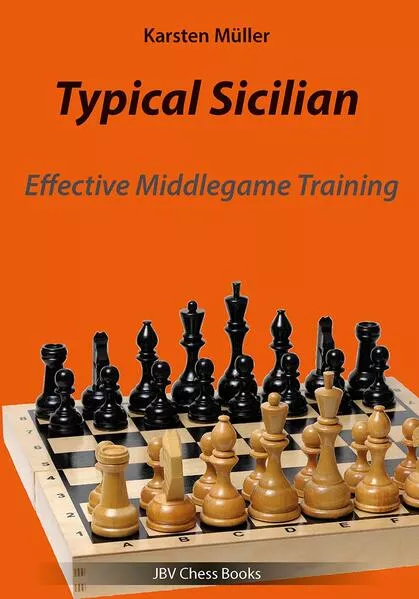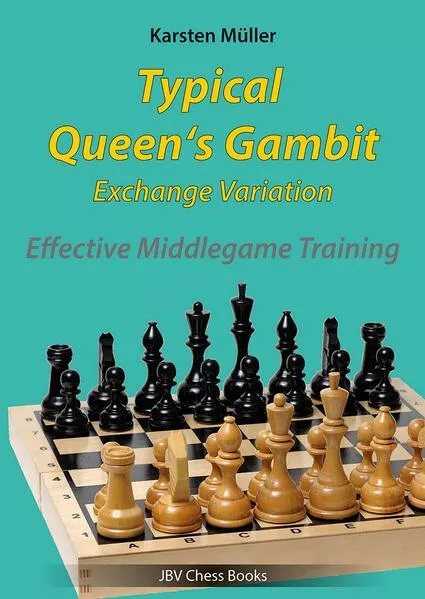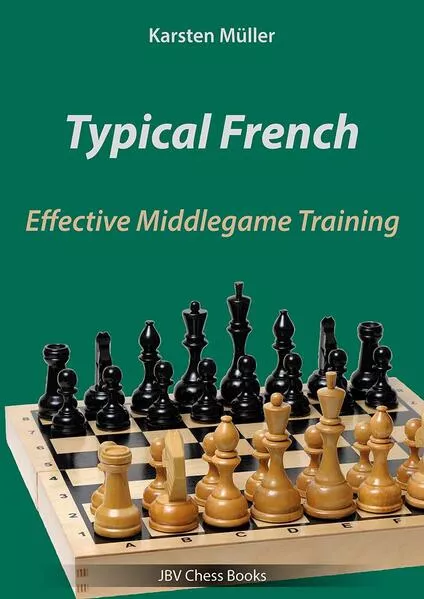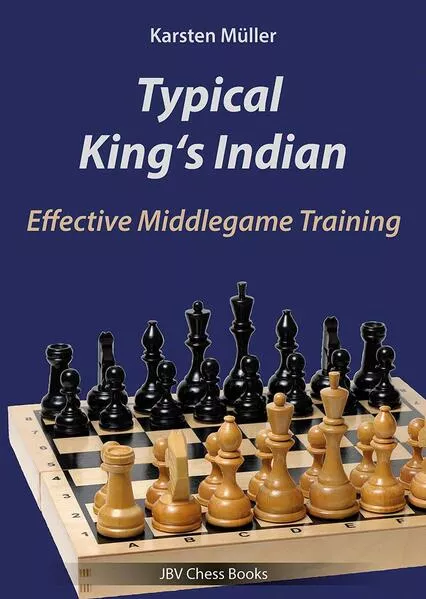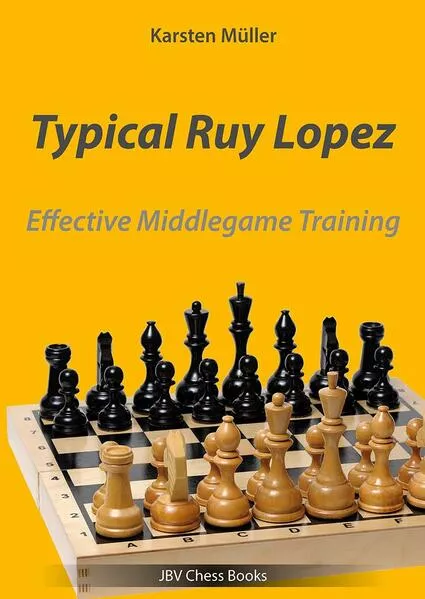Chronologie aller Bände (1 - 5)
Die Reihenfolge beginnt mit dem Buch "Typical Sicilian". Wer alle Bücher der Reihe nach lesen möchte, sollte mit diesem Band von Karsten Müller beginnen. Der zweite Teil der Reihe "Typical Sicilian" ist am 24.01.2023 erschienen. Mit insgesamt 5 Bänden wurde die Reihe über einen Zeitraum von ungefähr 2 Jahren fortgesetzt. Der neueste Band trägt den Titel "Typical Ruy Lopez".
- Anzahl der Bewertungen für die gesamte Reihe: 6
- Ø Bewertung der Reihe: 5
- Start der Reihe: 24.01.2023
- Neueste Folge: 27.01.2025
- Autor: Müller, Karsten
- Anzahl Bewertungen: 3
- Ø Bewertung: 5.0
- Medium: Buch
- Veröffentlicht: 24.01.2023
- Genre: Ratgeber
Typical Sicilian
In designing this book, the author was guided by the following considerations. If you want to learn this or that opening, you can choose from dozens or even hundreds of textbooks. But what if you want to get familiar with the middlegame strategy used in positions that have emerged from exactly this or that opening? Or to put it another way: in positions that are typical for this or that opening.
Of course, in every middlegame textbook there's one or the other position that clearly comes from this or that opening. However, their number is negligible in the context of example positions from all the other openings whose middlegame treatment the reader doesn't want to learn at all.
For example, aren't the issues of hanging pawns and minority attack – the author asks with good reason – just as dispensable for an e4 player as they are essential for a d4 player? – Why should a die-hard enthusiast of Indian openings care about the strategic intricacies of positions resulting from all those complicated Queen's Gambit systems? And of course vice versa: what use are all these subtleties of Indian positions to a player who 'by nature' avoids fianchetto openings?
And it's precisely this conspicuous and astounding vacuum in the area of middlegame literature that inspired the author to make a appropriate attempt at improvement: If you want to learn Sicilian middlegame strategy, you will get a textbook and exercise book in which only Sicilians are treated.
However, this current book only deals with the type 'Open Sicilian'. More precisely: with positions characterized by the 'small center' consisting of the pawns on d6 and e6, which is typical for the vast majority of Sicilian systems.
It deserves special mention that the more than 150 exercises have been assigned to specific topics for the benefit of entertaining diversity - for example 'the relegation candidate', 'the only move', 'violence or pressure increase' and the like.
Of course, in every middlegame textbook there's one or the other position that clearly comes from this or that opening. However, their number is negligible in the context of example positions from all the other openings whose middlegame treatment the reader doesn't want to learn at all.
For example, aren't the issues of hanging pawns and minority attack – the author asks with good reason – just as dispensable for an e4 player as they are essential for a d4 player? – Why should a die-hard enthusiast of Indian openings care about the strategic intricacies of positions resulting from all those complicated Queen's Gambit systems? And of course vice versa: what use are all these subtleties of Indian positions to a player who 'by nature' avoids fianchetto openings?
And it's precisely this conspicuous and astounding vacuum in the area of middlegame literature that inspired the author to make a appropriate attempt at improvement: If you want to learn Sicilian middlegame strategy, you will get a textbook and exercise book in which only Sicilians are treated.
However, this current book only deals with the type 'Open Sicilian'. More precisely: with positions characterized by the 'small center' consisting of the pawns on d6 and e6, which is typical for the vast majority of Sicilian systems.
It deserves special mention that the more than 150 exercises have been assigned to specific topics for the benefit of entertaining diversity - for example 'the relegation candidate', 'the only move', 'violence or pressure increase' and the like.
- Autor: Müller, Karsten
- Anzahl Bewertungen: 2
- Ø Bewertung: 5.0
- Medium: Buch
- Veröffentlicht: 28.11.2023
- Genre: Ratgeber
Typical Queen´s Gambit - Exchange Variation
In designing this book, the author was guided by the following considerations. If you want to learn this or that opening, you can choose from dozens or even hundreds of textbooks. But what if you want to get familiar with the middlegame strategy used in positions that have emerged from exactly this or that opening? Or to put it another way: in positions that are typical for this or that opening.
Of course, in every middlegame textbook there's one or the other position that clearly comes from this or that opening. However, their number is negligible in the context of example positions from all the other openings whose middlegame treatment the reader doesn't want to learn at all.
For example, aren't the issues of hanging pawns and minority attack – the author asks with good reason – just as dispensable for an e4 player as they are essential for a d4 player? – Why should a die-hard enthusiast of Indian openings care about the strategic intricacies of positions resulting from all those complicated Queen's Gambit systems? And of course vice versa: what use are all these subtleties of Indian positions to a player who 'by nature' avoids fianchetto openings?
And it's precisely this conspicuous and astounding vacuum in the area of middlegame literature that inspired the author to make an appropriate attempt at improvement: If you want to learn Sicilian middlegame strategy, you will get a textbook and exercise book in which only Sicilians are
treated.
However, this book only deals with the Queen's Gambit – more precisely: the Exchange Variation with white pawns on e3 and d4 against black pawns on c6 and d5 – the so-called 'Carlsbad structure'.
It deserves special mention that the 120 exercises have been assigned to specific topics for the benefit of entertaining diversity – for example 'the relegation candidate', 'the only move', 'violence or pressure increase' and the like.
Of course, in every middlegame textbook there's one or the other position that clearly comes from this or that opening. However, their number is negligible in the context of example positions from all the other openings whose middlegame treatment the reader doesn't want to learn at all.
For example, aren't the issues of hanging pawns and minority attack – the author asks with good reason – just as dispensable for an e4 player as they are essential for a d4 player? – Why should a die-hard enthusiast of Indian openings care about the strategic intricacies of positions resulting from all those complicated Queen's Gambit systems? And of course vice versa: what use are all these subtleties of Indian positions to a player who 'by nature' avoids fianchetto openings?
And it's precisely this conspicuous and astounding vacuum in the area of middlegame literature that inspired the author to make an appropriate attempt at improvement: If you want to learn Sicilian middlegame strategy, you will get a textbook and exercise book in which only Sicilians are
treated.
However, this book only deals with the Queen's Gambit – more precisely: the Exchange Variation with white pawns on e3 and d4 against black pawns on c6 and d5 – the so-called 'Carlsbad structure'.
It deserves special mention that the 120 exercises have been assigned to specific topics for the benefit of entertaining diversity – for example 'the relegation candidate', 'the only move', 'violence or pressure increase' and the like.
- Autor: Müller, Karsten
- Anzahl Bewertungen: 1
- Ø Bewertung: 5.0
- Medium: Buch
- Veröffentlicht: 05.04.2024
- Genre: Ratgeber
Typical French
In designing this book, the author was guided by the following consid- erations. If you want to learn this or that opening, you can choose from dozens or even hundreds of textbooks. But what if you want to get familiar with the middlegame strategy used in positions that have emerged from exactly this or that opening? Or to put it another way: in positions that are typical for this or that opening.
Of course, in every middlegame textbook there's one or the other position that clearly comes from this or that opening. However, their number is negligible in the context of example positions from all the other openings whose middlegame treatment the reader doesn't want to learn at all.
For example, aren't the issues of hanging pawns and minority attack – the author asks with good reason – just as dispensable for an e4 player as they are essential for a d4 player? – Why should a die-hard enthusiast of Indian openings care about the strategic intricacies of positions resulting from all those complicated Queen's Gambit systems? And of course vice versa: what use are all these subtleties of Indian positions to a player who by nature avoids fianchetto openings?
And it's precisely this conspicuous and astounding vacuum in the area of middlegame literature that inspired the author to make an appropriate attempt at improvement: If you want to learn French middlegame strategy, you will get a textbook and exercise book in which only French middlegames are treated. However, this book only deals with positions in which the white pawns on d4 and e5 are opposed by black pawns on d5 and e6 – or those positions that can arise from this basic structure, as shown in detail in the overview following the preface.
It deserves special mention that the 110 exercises have been assigned to specific topics for the benefit of entertaining diversity – for example the top candidate, the relegation candidate, the only move, violence or pressure increase but also joke articles and the like.
Of course, in every middlegame textbook there's one or the other position that clearly comes from this or that opening. However, their number is negligible in the context of example positions from all the other openings whose middlegame treatment the reader doesn't want to learn at all.
For example, aren't the issues of hanging pawns and minority attack – the author asks with good reason – just as dispensable for an e4 player as they are essential for a d4 player? – Why should a die-hard enthusiast of Indian openings care about the strategic intricacies of positions resulting from all those complicated Queen's Gambit systems? And of course vice versa: what use are all these subtleties of Indian positions to a player who by nature avoids fianchetto openings?
And it's precisely this conspicuous and astounding vacuum in the area of middlegame literature that inspired the author to make an appropriate attempt at improvement: If you want to learn French middlegame strategy, you will get a textbook and exercise book in which only French middlegames are treated. However, this book only deals with positions in which the white pawns on d4 and e5 are opposed by black pawns on d5 and e6 – or those positions that can arise from this basic structure, as shown in detail in the overview following the preface.
It deserves special mention that the 110 exercises have been assigned to specific topics for the benefit of entertaining diversity – for example the top candidate, the relegation candidate, the only move, violence or pressure increase but also joke articles and the like.
- Autor: Müller, Karsten
- Anzahl Bewertungen: 0
- Ø Bewertung:
- Medium: Buch
- Veröffentlicht: 15.08.2024
- Genre: Ratgeber
Typical King´s Indian
In designing this book, the author was guided by the following considerations. If you want to learn this or that opening, you can choose from dozens or even hundreds of textbooks. But what if you want to get familiar with the middlegame strategy used in positions that have emerged from exactly this or that opening? Or to put it another way: in positions that are typical for this or that opening.
Of course, in every middlegame textbook there's one or the other position that clearly comes from this or that opening. However, their number is negligible in the context of example positions from all the other openings whose middlegame treatment the reader doesn't want to learn at all.
For example, aren't the issues of hanging pawns and minority attack – the author asks with good reason – just as dispensable for an e4 player as they are essential for a d4 player? – Why should a die-hard enthusiast of Indian openings care about the strategic intricacies of positions resulting from all those complicated Queen's Gambit systems? And of course vice versa: what use are all these subtleties of Indian positions to a player who by nature avoids fianchetto openings?
And it's precisely this conspicuous and astounding vacuum in the area of middlegame literature that inspired the author to make an appropriate attempt at improvement: If you want to learn typical King's Indian middle game strategy, you will get a textbook and exercise book in which only King's Indian is played.
However, this volume only deals with positions in which Black attacks the white pawns on c4, d4 and e4 with the central push e7-e5 (and not c7-c5) – or those positions that can arise from this basic structure, as shown in detail in the overview following the preface.
It deserves special mention that the 100 exercises have been assigned to specific topics for the benefit of entertaining diversity – for example the relegation candidate, the only move, violence or pressure increase and the like.
Of course, in every middlegame textbook there's one or the other position that clearly comes from this or that opening. However, their number is negligible in the context of example positions from all the other openings whose middlegame treatment the reader doesn't want to learn at all.
For example, aren't the issues of hanging pawns and minority attack – the author asks with good reason – just as dispensable for an e4 player as they are essential for a d4 player? – Why should a die-hard enthusiast of Indian openings care about the strategic intricacies of positions resulting from all those complicated Queen's Gambit systems? And of course vice versa: what use are all these subtleties of Indian positions to a player who by nature avoids fianchetto openings?
And it's precisely this conspicuous and astounding vacuum in the area of middlegame literature that inspired the author to make an appropriate attempt at improvement: If you want to learn typical King's Indian middle game strategy, you will get a textbook and exercise book in which only King's Indian is played.
However, this volume only deals with positions in which Black attacks the white pawns on c4, d4 and e4 with the central push e7-e5 (and not c7-c5) – or those positions that can arise from this basic structure, as shown in detail in the overview following the preface.
It deserves special mention that the 100 exercises have been assigned to specific topics for the benefit of entertaining diversity – for example the relegation candidate, the only move, violence or pressure increase and the like.
- Autor: Müller, Karsten
- Anzahl Bewertungen: 0
- Ø Bewertung:
- Medium: Buch
- Veröffentlicht: 27.01.2025
- Genre: Ratgeber
Typical Ruy Lopez
In designing this book, the author was guided by the following considerations. If you want to learn this or that opening, you can choose from dozens or even hundreds of textbooks. But what if you want to get familiar with the middlegame strategy used in positions that have emerged from exactly this or that opening? Or to put it another way: in positions that are typical for this or that opening.
Of course, in every middlegame textbook there's one or the other position that clearly comes from this or that opening. However, their number is negligible in the context of example positions from all the other openings whose middlegame treatment the reader doesn't want to learn at all.
For example, aren't the issues of hanging pawns and minority attack - the author asks with good reason – just as dispensable for an e4 player as they are essential for a d4 player? – Why should a die-hard enthusiast of Indian openings care about the strategic intricacies of positions resulting from all those complicated Queen's Gambit systems? And of course vice versa: what use are all these subtleties of Indian positions to a player who by nature avoids fianchetto openings?
And it's precisely this conspicuous and astounding vacuum in the area of middlegame literature that inspired the author to make an appropriate attempt at improvement: If you want to learn typical middlegame strategy of the Ruy Lopez, you will get a textbook and exercise book in which only Ruy Lopez middlegames are treated. However, this book only deals with positions in which the white pawns on c3, d4 and e4 are opposed by black pawns on e5 and d6 – or those positions that can arise from this basic structure, as shown in detail in the overview following the preface.
It deserves special mention that the more than 100 exercises have been assigned to specific topics for the benefit of entertaining diversity – for example the relegation candidate, the only move, violence or pressure increase and the like.
Of course, in every middlegame textbook there's one or the other position that clearly comes from this or that opening. However, their number is negligible in the context of example positions from all the other openings whose middlegame treatment the reader doesn't want to learn at all.
For example, aren't the issues of hanging pawns and minority attack - the author asks with good reason – just as dispensable for an e4 player as they are essential for a d4 player? – Why should a die-hard enthusiast of Indian openings care about the strategic intricacies of positions resulting from all those complicated Queen's Gambit systems? And of course vice versa: what use are all these subtleties of Indian positions to a player who by nature avoids fianchetto openings?
And it's precisely this conspicuous and astounding vacuum in the area of middlegame literature that inspired the author to make an appropriate attempt at improvement: If you want to learn typical middlegame strategy of the Ruy Lopez, you will get a textbook and exercise book in which only Ruy Lopez middlegames are treated. However, this book only deals with positions in which the white pawns on c3, d4 and e4 are opposed by black pawns on e5 and d6 – or those positions that can arise from this basic structure, as shown in detail in the overview following the preface.
It deserves special mention that the more than 100 exercises have been assigned to specific topics for the benefit of entertaining diversity – for example the relegation candidate, the only move, violence or pressure increase and the like.
